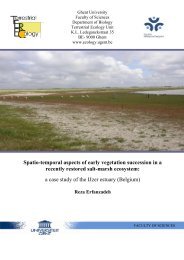PhD Arthur Decae 2010 - Ghent Ecology - Universiteit Gent
PhD Arthur Decae 2010 - Ghent Ecology - Universiteit Gent
PhD Arthur Decae 2010 - Ghent Ecology - Universiteit Gent
You also want an ePaper? Increase the reach of your titles
YUMPU automatically turns print PDFs into web optimized ePapers that Google loves.
of the burrow (by the spider collector), N. santeulalia will initially hold on to the trapdoor to<br />
keep it closed. When the trapdoor is forced open the spider will retreat to the bottom of the<br />
burrow and wait there head-up. When further disturbed, it will finally run up the burrow again<br />
to hide in the side tube. The spiders were not aggressive and were hardly ever observed to<br />
bite. Analysis of the indigestible remains of prey found in the burrow bottoms and walls<br />
revealed head -capsules, legs and mandibles of ants, legs and elytra of beetles and possibly<br />
remains of woodlice. Probably such ground-dwelling arthropods constitute the main prey of<br />
N. santeulalia, although other types of prey cannot be ruled out on the grounds of this<br />
observation alone 14 .<br />
Distribution (Fig. 86): Nemesia santeulalia was found to be common in quite widely<br />
separated places on Ibiza. It has not so far been found on the nearby island of Formentera.<br />
Nemesia ibiza sp. n. (Figs. 61-67, 74, 85)<br />
Types: Holotype ♀(AR 14067), 3 May 1986, Ibiza, San Juan, 39.081°N, 1.510°E, burrow in<br />
clay-fillings between limestone rocks. Paratypes: IBIZA: 1 ♀ (ARI4065), 3 May 1986, same<br />
data as holotype; 2 ♀♀ (AR 14066; 9972.4018), 10 May 1986, Figueritas, 38.911°N,<br />
1.416°E, horizontal and slightly sloping ground in wasteland on building site; 2♀♀<br />
(9972.4019, 9972.4020), 8 May 1986, Santa Eulalia del Rio, 38.987°N, 1.530°E, in clay-bank<br />
along road between pine forest and village edge. All specimen leg. A. E. <strong>Decae</strong>. All locations<br />
mentioned here are on Ibiza, but the species was also found near Punta de la Anguila on the<br />
nearby island of Formentera.<br />
Etymology: The specific name is a noun in apposition taken from the type locality, the island<br />
of Ibiza, where it was found to be common and widely distributed.<br />
Diagnosis: Females of N. ibiza can be distinguished from an other known Nemesia species by<br />
the "hour- glass" shape of the spermathecae (Fig. 67), particularly the proximal narrowing of<br />
the receptacula seems to be characteristic. The male is unknown.<br />
Note: Nemesia ibiza seems to be closely related to N. hispanica, because some differences<br />
observed in the morphology of the two species (eye-formation, spine pattern, morphology of<br />
legs III and IV) may fall within the range of geographical variation of N. hispanica. However,<br />
on the grounds of the observed differences, the limited material of N. hispanica, and the<br />
absence of males of both species, N. ibiza is here regarded as a distinct species.<br />
Description: Female (holotype): BL = 20.4, CL = 7.4, CW = 6.7. Leg IV: F4>T4>M4. PSP: p<br />
= 2-2; I = 1-1; II = 1-1; III = 2-2; IV = 0-0. Dorsal aspect (Fig. 62). Carapace slightly longer<br />
than wide, CL/CW = 1.1, yellowish brown with "leaf pattern" of darker zones radiating from<br />
fovea and along cervical grooves and radial furrows, setae along anterior edge of clypeus and<br />
on ocular tubercle. Caput elevated, Ch/Th = 1.9, groups of fine setae on each side of central<br />
longitudinal row of stronger bristles on crest of caput, pubescence absent, but widely<br />
dispersed fine hairs present. Clypeus yellowish, relatively wide, Clyp = 0.36. Eye-group (Fig.<br />
64) almost rectangular, AR/PR = 0.96, less than twice as wide as long, AR/El = 1.87, ALE<br />
largest, ALE/PLE = 1.17, anterior eyes greyish, posterior eyes pearly. POP broken between<br />
AME and lateral eyes. Fovea not smoothly recurved, but somewhat angular. Chelicerae warm<br />
reddish brown, darker than and contrasting with overall color of carapace, with narrow dark<br />
brown glabrous zone dorso-laterally, cheliceral furrow with seven promarginal teeth, distal<br />
14 Ants, beetles and woodlice were observed to be captured and eaten by other Nemesia species in captivity. Other types of<br />
prey such as earthworms, maggots, flies and earwigs, were captured and eaten and even food items that cannot possibly be<br />
part of their natural diet, such as pieces of prawn and tiny meatballs placed on the burrow rim were accepted as food. These<br />
observations indicate that Nemesia trapdoor spiders are food generalists.










